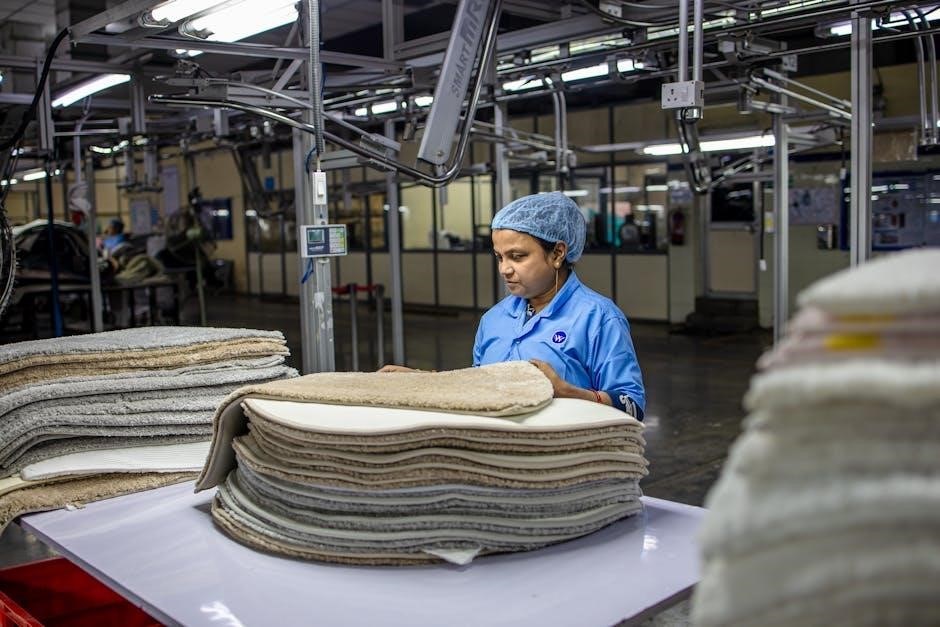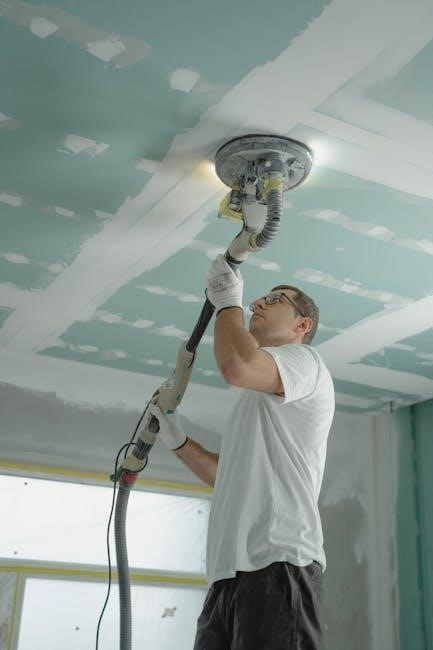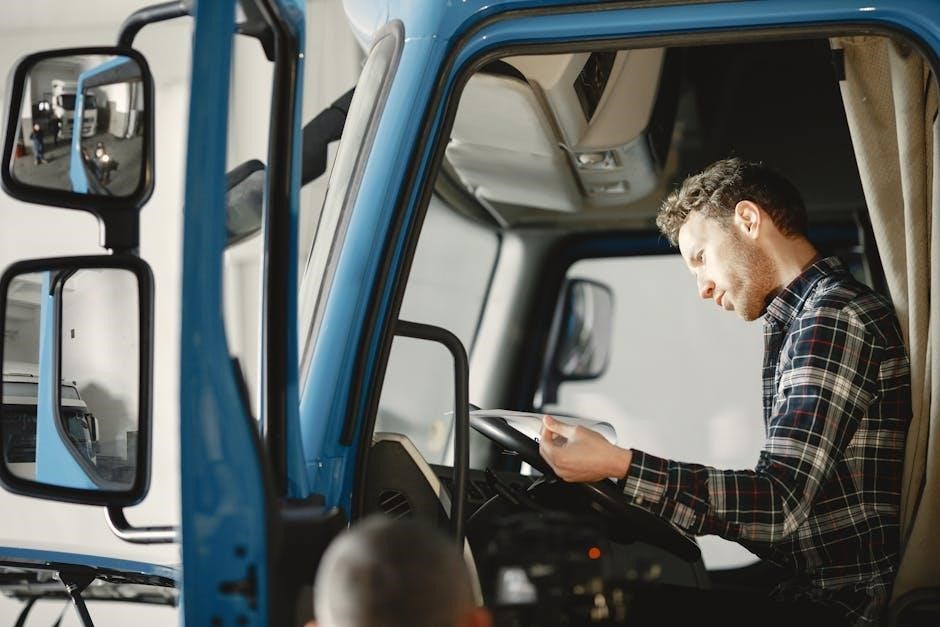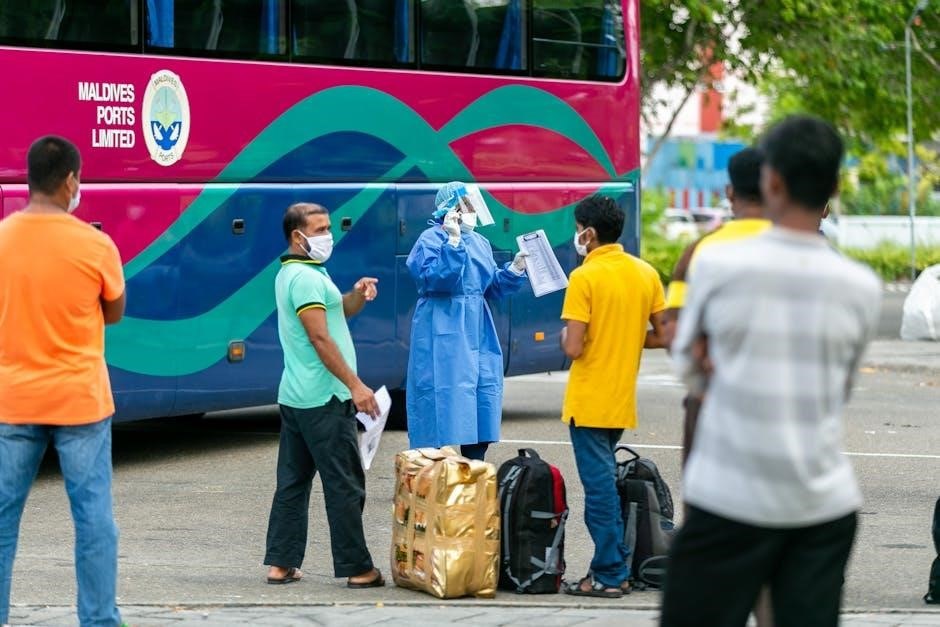A pre-drywall inspection ensures all structural‚ electrical‚ and plumbing components are reviewed before installation begins‚ helping identify potential issues early and streamline the construction process effectively.
1.1 Importance of Pre-Drywall Inspection
A pre-drywall inspection is crucial for identifying potential issues with framing‚ plumbing‚ and electrical systems before they become costly to repair. It ensures all components meet industry standards and safety protocols. Early detection of problems prevents delays and ensures a secure living environment. A detailed checklist guides inspectors through critical areas‚ streamlining the process and guaranteeing thoroughness.
1.2 Benefits of Using a Checklist
A pre-drywall inspection checklist streamlines the process‚ ensuring no critical areas are overlooked. It provides a structured approach to review electrical‚ plumbing‚ and structural components. Using a checklist enhances efficiency‚ accountability‚ and accuracy. It also serves as a permanent record‚ offering clarity and peace of mind for future reference‚ ensuring all issues are addressed before drywall installation begins.

Foundation and Framing Inspection
Inspecting the foundation and framing ensures structural integrity by checking for cracks‚ unevenness‚ and proper alignment. This step is crucial for identifying potential issues early‚ ensuring safety and durability in the building process.
2.1 Checking for Cracks and Unevenness
Inspecting for cracks and unevenness in the foundation and framing is critical to ensure structural stability. Look for any signs of shifting‚ water damage‚ or settling that could compromise the building’s integrity. Use a level and flashlight to thoroughly examine surfaces‚ and document any areas requiring repair. Addressing these issues early prevents costly fixes later and ensures a secure base for the entire structure.
2.2 Ensuring Proper Framing Alignment
Proper framing alignment is essential for structural integrity. Use a level and plumb line to verify that all walls‚ beams‚ and columns are straight and properly supported. Check load-bearing elements for accurate placement and ensure they are securely fastened. Misalignment can lead to serious structural issues‚ so addressing any discrepancies during this stage is crucial for long-term stability and safety. Early detection prevents costly repairs later.

Electrical System Review
An electrical system review ensures all wiring‚ outlets‚ and components are correctly installed and meet safety standards before drywall installation begins‚ preventing future electrical hazards and ensuring functionality.
3.1 Verifying Outlet Locations
Verifying outlet locations ensures they are correctly positioned according to the construction plans and meet the homeowner’s needs. This step checks for proper alignment‚ spacing‚ and functionality‚ preventing costly rework later. Reviewing outlet placements also ensures compliance with safety standards and accommodates any upgrades or special requests. A pre-drywall checklist helps streamline this process‚ ensuring all outlets are correctly installed and functional before drywall installation begins.
3.2 Checking for Proper Wiring Connections
Checking for proper wiring connections ensures all electrical systems are securely installed and meet safety standards. This involves verifying that wires are correctly connected‚ circuits are properly labeled‚ and all components comply with local building codes. A pre-drywall inspection checklist helps identify loose connections‚ improper wiring‚ or missing components‚ preventing potential hazards and ensuring reliable electrical performance once the drywall is installed and the project is complete.

Plumbing System Inspection
A pre-drywall plumbing inspection ensures pipes are correctly installed‚ properly connected‚ and free from leaks or damage‚ verifying compliance with local building codes for safe water distribution.
4.1 Identifying Leaks and Damage
During the pre-drywall inspection‚ carefully check all plumbing pipes‚ joints‚ and connections for any signs of leaks‚ cracks‚ or corrosion. Ensure there are no loose fittings or damaged components that could lead to future water damage or mold growth. Addressing these issues early prevents costly repairs and ensures the plumbing system functions safely and efficiently after drywall installation.
Verify that all pipes are correctly sized‚ securely fastened‚ and properly vented to maintain optimal water flow and prevent future issues. Check that connections are tight‚ and pipes are adequately supported to avoid sagging or damage. Ensure compliance with local building codes and that all materials meet quality standards for durability and safety in the plumbing system.
Insulation and Vapor Barrier Check
4.2 Ensuring Proper Pipe Installation
Verify that pipes are correctly sized‚ securely fastened‚ and properly vented to ensure optimal water flow and prevent future issues. Check for leaks‚ proper connections‚ and adequate support to avoid damage or sagging‚ ensuring compliance with local building codes and quality standards for safety and durability in the plumbing system.
5.1 Verifying Insulation Coverage
Ensure insulation is properly installed‚ with adequate coverage in walls‚ ceilings‚ and floors. Verify thickness‚ material quality‚ and placement to meet local building codes and energy efficiency standards. Check for gaps‚ compression‚ or misalignment that could compromise performance. Proper insulation ensures thermal regulation‚ reduces noise‚ and prevents moisture issues‚ making it a critical step in the pre-drywall inspection process for long-term comfort and energy savings.
5.2 Ensuring Proper Vapor Barrier Installation
Inspect the vapor barrier to ensure it is correctly installed‚ with no tears‚ gaps‚ or improper seams. Verify that it is properly sealed at edges‚ penetrations‚ and transitions. Ensure compliance with local building codes and manufacturer guidelines. Proper vapor barrier installation prevents moisture accumulation‚ reducing the risk of mold‚ rot‚ and structural damage. This step is crucial for maintaining indoor air quality and long-term durability.

Safety and Compliance Standards
Adhering to local building codes and safety protocols ensures a secure environment. Compliance checks during pre-drywall inspections prevent future issues and guarantee all systems meet industry standards. Proper safety measures protect both the structure and occupants‚ while ensuring work is done correctly. Addressing compliance early avoids costly rework and potential hazards. A safe‚ compliant build is essential for long-term durability and reliability. Always verify that all installations meet current safety regulations and standards before proceeding with drywall installation. This step is critical for preventing future issues and ensuring a safe living environment. Regular inspections and adherence to guidelines help maintain quality and safety throughout the construction process. Ensuring compliance with safety standards is a fundamental aspect of responsible construction practices. By following established protocols‚ contractors can deliver a secure and well-constructed home. Safety should never be compromised‚ as it directly impacts the well-being of the building’s occupants. Conducting thorough compliance checks during the pre-drywall phase minimizes risks and ensures a smooth construction process. Compliance with safety standards is non-negotiable in modern construction‚ protecting both workers and future residents. A safe and compliant build is the foundation of a successful project. Always prioritize safety and compliance to avoid potential dangers and legal issues. Properly implemented safety measures ensure a safe working environment and a secure final product. Compliance with local regulations is essential for avoiding fines and ensuring the project’s approval. Safety standards are in place to protect everyone involved‚ from construction workers to future homeowners. Ensuring compliance with these standards is a legal and moral obligation. A safe and compliant construction site is a productive and efficient one. Prioritizing safety and compliance leads to better outcomes and higher-quality results. Always take the time to verify that all aspects of the build meet or exceed safety standards. Compliance with safety regulations is a critical step in the pre-drywall inspection process. Ensuring safety and compliance protects the integrity of the building and the well-being of its occupants. Proper safety measures and adherence to local codes are essential for a successful pre-drywall inspection. Safety and compliance are the cornerstones of a reliable and durable construction project. Always ensure that all safety standards are met before proceeding with drywall installation. A safe and compliant build is the key to a secure and comfortable living environment. Compliance with safety standards ensures that the building is structurally sound and safe for occupancy. Always prioritize safety and compliance during the pre-drywall inspection to avoid future complications. Ensuring safety and compliance is a critical step in the construction process that should never be overlooked. Proper safety measures and adherence to local codes ensure a safe and secure building. Compliance with safety standards during the pre-drywall phase guarantees a safe and well-constructed home. Safety and compliance are essential for protecting both the structure and its occupants. Always ensure that all safety protocols are followed during the pre-drywall inspection. A safe and compliant build is the result of careful planning and adherence to industry standards. Compliance with safety regulations ensures that the building meets all necessary requirements for safety and durability. Proper safety measures and compliance checks are vital for a successful pre-drywall inspection. Ensuring safety and compliance is a fundamental aspect of responsible construction practices. Always verify that all safety standards are met before proceeding with drywall installation. A safe and compliant build is essential for the well-being of future occupants. Compliance with safety standards ensures that the building is safe‚ secure‚ and meets all legal requirements. Proper safety measures and adherence to local codes are critical during the pre-drywall phase. Ensuring safety and compliance guarantees a safe and durable construction project. Safety and compliance are non-negotiable in modern construction‚ protecting both workers and future residents. Always prioritize safety and compliance during the pre-drywall inspection to ensure a secure and well-constructed home. Compliance with safety standards is essential for avoiding potential hazards and legal issues. Proper safety measures ensure a safe working environment and a secure final product. Safety and compliance are the foundation of a successful construction project. Always ensure that all safety protocols are followed during the pre-drywall phase. A safe and compliant build is the result of careful planning and adherence to industry standards. Compliance with safety regulations ensures that the building meets all necessary requirements for safety and durability. Proper safety measures and compliance checks are vital for a successful pre-drywall inspection. Ensuring safety and compliance is a fundamental aspect of responsible construction practices. Always verify that all safety standards are met before proceeding with drywall installation. A safe and compliant build is essential for the well-being of future occupants. Compliance with safety standards ensures that the building is safe‚ secure‚ and meets all legal requirements. Proper safety measures and adherence to local codes are critical during the pre-drywall phase. Ensuring safety and compliance guarantees a safe and durable construction project. Safety and compliance are non-negotiable in modern construction‚ protecting both workers and future residents. Always prioritize safety and compliance during the pre-drywall inspection to ensure a secure and well-constructed home. Compliance with safety standards is essential for avoiding potential hazards and legal issues. Proper safety measures ensure a safe working environment and a secure final product. Safety and compliance are the foundation of a successful construction project. Always ensure that all safety protocols are followed during the pre-drywall phase. A safe and compliant build is the result of careful planning and adherence to industry standards. Compliance with safety regulations ensures that the building meets all necessary requirements for safety and durability. Proper safety measures and compliance checks are vital for a successful pre-drywall inspection. Ensuring safety and compliance is a fundamental aspect of responsible construction practices. Always verify that all safety standards are met before proceeding with drywall installation. A safe and compliant build is essential for the well-being of future occupants. Compliance with safety standards ensures that the building is safe‚ secure‚ and meets all legal requirements. Proper safety measures and adherence to local codes are critical during the pre-drywall phase. Ensuring safety and compliance guarantees a safe and durable construction project. Safety and compliance are non-negotiable in modern construction‚ protecting both workers and future residents. Always prioritize safety and compliance during the pre-drywall inspection to ensure a secure and well-constructed home. Compliance with safety standards is essential for avoiding potential hazards and legal issues. Proper safety measures ensure a safe working environment and a secure final product. Safety and compliance are the foundation of a successful construction project. Always ensure that all safety protocols are followed during the pre-drywall phase. A safe and compliant build is the result of careful planning and adherence to industry standards. Compliance with safety regulations ensures that the building meets all necessary requirements for safety and durability. Proper safety measures and compliance checks are vital for a successful pre-drywall inspection. Ensuring safety and compliance is a fundamental aspect of responsible construction practices. Always verify that all safety standards are met before proceeding with drywall installation. A safe and compliant build is essential for the well-being of future occupants. Compliance with safety standards ensures that the building is safe‚ secure‚ and meets all legal requirements. Proper safety measures and adherence to local codes are critical during the pre-drywall phase. Ensuring safety and compliance guarantees a safe and durable construction project. Safety and compliance are non-negotiable in modern construction‚ protecting both workers and future residents. Always prioritize safety and compliance during the pre-drywall inspection to ensure a secure and well-constructed home. Compliance with safety standards is essential for avoiding potential hazards and legal issues; Proper safety measures ensure a safe working environment and a secure final product. Safety and compliance are the foundation of a successful construction project; Always ensure that all safety protocols are followed during the pre-drywall phase. A safe and compliant build is the result of careful planning and adherence to industry standards. Compliance with safety regulations ensures that the building meets all necessary requirements for safety and durability. Proper safety measures and compliance checks are vital for a successful pre-drywall inspection. Ensuring safety and compliance is a fundamental aspect of responsible construction practices. Always verify that all safety standards are met before proceeding with drywall installation. A safe and compliant build is essential for the well-being of future occupants. Compliance with safety standards ensures that the building is safe‚ secure‚ and meets all legal requirements. Proper safety measures and adherence to local codes are critical during the pre-drywall phase. Ensuring safety and compliance guarantees a safe and durable construction project. Safety and compliance are non-negotiable in modern construction‚ protecting both workers and future residents. Always prioritize safety and compliance during the pre-drywall inspection to ensure a secure and well-constructed home. Compliance with safety standards is essential for avoiding potential hazards and legal issues. Proper safety measures ensure a safe working environment and a secure final product. Safety and compliance are the foundation of a successful construction project. Always ensure that all safety protocols are followed during the pre-drywall phase. A safe and compliant build is the result of careful planning and adherence to industry standards. Compliance with safety regulations ensures that the building meets all necessary requirements for safety and durability. Proper safety measures and compliance checks are vital for a successful pre-drywall inspection. Ensuring safety and compliance is a fundamental aspect of responsible construction practices. Always verify that all
6.1 Adherence to Local Building Codes
Adherence to local building codes during pre-drywall inspection ensures compliance with safety and structural standards. This step verifies that electrical‚ plumbing‚ and framing systems meet regulatory requirements‚ preventing legal issues and costly rework. A checklist helps confirm that all installations align with codes‚ ensuring a safe and durable structure. Compliance guarantees the building’s integrity and avoids potential hazards‚ making it a critical step in the inspection process.

Leave a Reply
You must be logged in to post a comment.